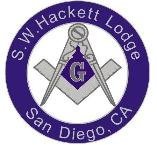|
American Sports Figure and inadvertent wit Yogi
Berra is credited with saying “If you don’t plan where you’re going,
you’ll end up someplace else”. I frequently take exactly this sort
of unplanned journey using the internet as my vehicle. More often
than not my starting place is some Masonic concept or bit of
symbolism which interests me, and on especially good journeys I
actually end up discovering things which a more rigid, planned
approach would have caused me to by-pass. The paper you are about to
read is the product of just this sort of journey.
While performing internet based research on the
symbolism of the “Point Within a Circle”, I happened upon a link to
a website which offers various mathematical proofs of Euclid's 47th
Proposition. One of these proofs immediately caught my eye, since it
had been developed by Brother James A. Garfield, the twentieth
President of the United States, and a Freemason. Bro. Garfields’
elegant and quite famous[i]
proof involves the construction of a trapezoid which is divided into
three separate right triangles[ii]
(Figure 1). Two of these triangles are congruent and one is an
Isoceles triangle. Garfield demonstrated through algebraic means
that the area of the trapezoid is equal to the sum of the areas of
the three right triangles and thereby proved that c2=a2
+ b2. Garfields’ proof, which I happened upon when I
also had the “Point Within a Circle” symbol fresh in my mind, led me
to consider whether the figure of the “Point Within a Circle” might
be used to construct a similar or even identical proof. As will be
demonstrated, the figure of a “Point Within a Circle” can not only
be used to construct a proof of Euclid's 47th
Proposition, it leads to the exact same method in doing so as that
which was published by President Garfield.
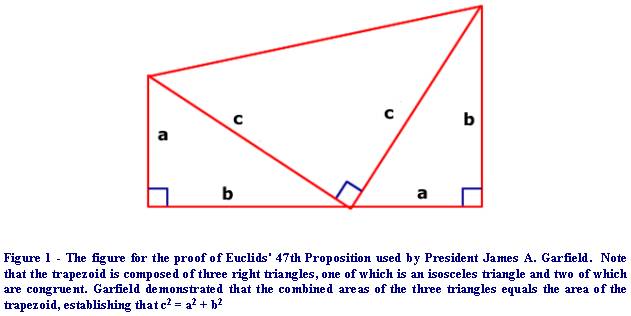
In order to prepare the reader for
this demonstration, I will present a brief and very basic discussion
concerning Euclid's 47th Proposition. Readers with a
greater interest or who may be interested in a more complete
discussion will find exhaustive reference material to this effect on
the internet. I will follow with the construction of the diagram I
used to demonstrate the proof in which the “Point Within a Circle”
is a critical element. Finally I will complete the algebraic portion
of the proof using the exact same equations and mathematical methods
used by Garfield. Please note that I do not claim this proof to be
original in any way other than the fact that it was developed using
the “Point Within a Circle” as the basis for constructing the figure
or diagram upon which Garfields’ proof is based.
Euclid's 47th Proposition
During ones’ journey through the rituals of
Freemasonry, it is nearly impossible to escape exposure to Euclid's
47th Proposition and the Masonic symbol which depicts the
proof of this amazing element of Geometry. Euclid's 47th
Proposition of course presents what we commonly call the Pythagorean
Theorem. The Pythagorean Theorem establishes that the square of the
length of the hypotenuse in a right triangle will equal the square
of the sums of the lengths of the other two sides. We state this
mathematically as c2 = a2 + b2 in
which “c” is the hypotenuse and “a” and “b” are the other two
sides.
Although we identify the Pythagorean Theorem with
the calculation of the length of the sides of a right triangle, its
basis of proof is actually in the calculation of areas. The
Pythagorean Theorem may be rephrased to state that the sum of the
area of the squares enclosing two sides of a right triangle will
equal the area of the square forming the side which is the
hypotenuse of that triangle. One figure often used to establish the
proof of this restated version of the Pythagorean Theorem is
provided by Figure 2. Brilliant use is made in this figure of the
first set of the Pythagorean Triples
[iii] 3, 4, and 5.

Much is made of Euclid's 47th
Proposition in Freemasonry, primarily in the third degree of the
Craft. While the value of this Proposition to an Operative Mason is
immediately apparent, its’ meaning to the Speculative Mason is
somewhat less so. The assumption of many Masons is that there is a
great and abiding allusion contained within the Theorem, but this
allusion is so heavily veiled or so subtle in meaning that it is
incomprehensible. I personally continue to search for more light in
Freemasonry through research in those areas which interest me. I
might add that my efforts have never failed to deliver a greater
understanding of the Craft.
I will begin my discussion of the proof of
Euclid's 47th Proposition with the simple expedient of
referring the reader to two seminal papers which describe the method
for inscribing a right triangle in a circle in accordance with the
Theorem of Thales. The first of these is contained in a paper[iv]
presented during the 222nd Anniversary of Independent
Royal Arch Lodge No. 2, F. & A.M. by Bro. Brent Morris. A second,
also very detailed, paper[v]
describing the use of this method to construct a right triangle is
given by Bro. William F. Bowe in The Builder Magazine. Both of these
articles explain Euclid's Theorems: Theorem 12, contained in Book
III of Euclid's Elements[vi]
in which it is stated that “An angle inscribed in a semi-circle is a
right angle”. This Theorem is based upon an even older Theorem to
the same effect developed by Greek Philosopher, Astronomer, and
Mathematician Thales of Miletus[vii].
As stated, my demonstration makes exclusive use
of the “Point Within a Circle” to develop the proof figure
introduced by President Garfield. Accordingly my initial step in
this proof is to draw the “Point Within a Circle” as a diagram,
which I have done in Figure 3. I have added to this figure a
straight line (“AB”) across the diameter of the circle and
perpendicular to the two parallel lines (lines “CD” and “EF”) at the
points at which these lines are tangent to the circle.
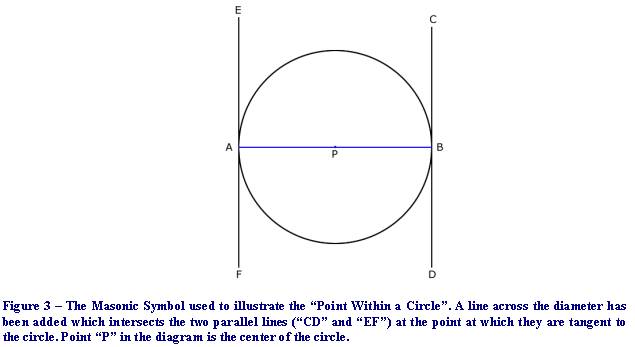
I next use Thales’ Theorem to construct a right
triangle (“ABV”) in the semicircle. I add line “PG” which begins at
the center point “P” of the circle and which extends through the
vertex of the right triangle (“point V”). Line “EH” is then added
which forms a perpendicular intersection at point “V”, establishing
itself as a line tangent to the circle at this point.
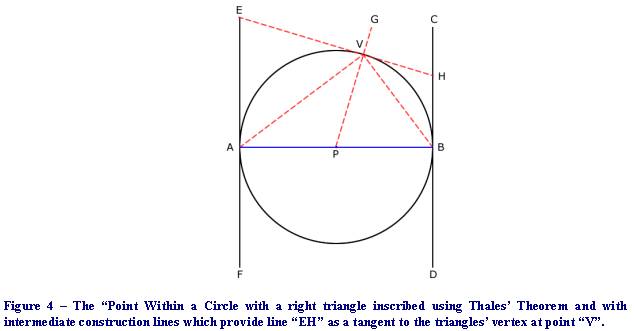
I now construct a line (“JN”)which forms a
perpendicular intersection at the midpoint of line “EH”. Note that
this line is parallel to line “PG” and intersects the diameter line
(“AB”) at point “N”. This is shown in Figure 5.
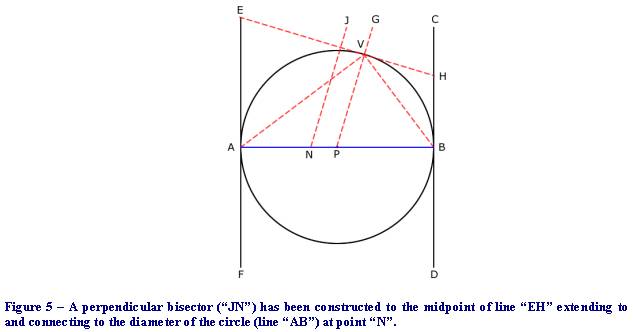
I next use a variation of Thales’ Theorem to
construct an Isosceles triangle by joining point “N” with the points
at which lines “CD” and “EF” are intersected by line “EH”. For those
who are interested in further reading concerning this technique for
creating a right triangle using a circle and tangent lines, I refer
them to an article[viii]
published in Pietre-Stones Review of Freemasonry which goes into
greater detail. Note that in constructing the isosceles triangle and
the various construction lines I have simultaneously created in this
figure a trapezoid (“ABHE”) composed of three right triangles, one
of which is an isosceles triangle and two of which are congruent. In
Figure 6 the trapezoid is outlined in blue for greater clarity.
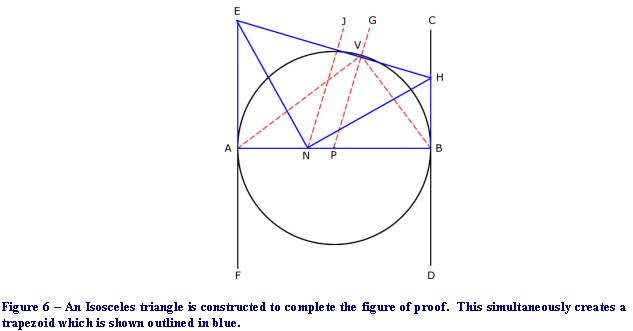
Figure 7 shows the trapezoid without the
construction lines and extraneous labels. I have labeled the bases
(“a” and “b”) of the trapezoid, and the hypotenuses of the two right
triangles (“c”). Note that the figure is nearly identical to that
used by Bro. Garfield; although I have constructed the figure at
hand with the slope of the trapezoid downhill. An uphill slope
(making the figure truly identical to Garfields’) would have simply
required construction of the Thales Triangle using a point left of
center as the vertex. Incidentally Bro. Garfield was left-handed[ix].
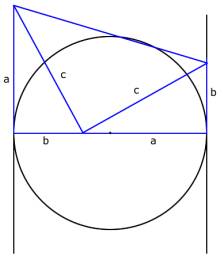
Using this proof figure and the associated labels
I apply the exact same algebraic sequence for developing the proof
as was applied by Bro. Garfield:
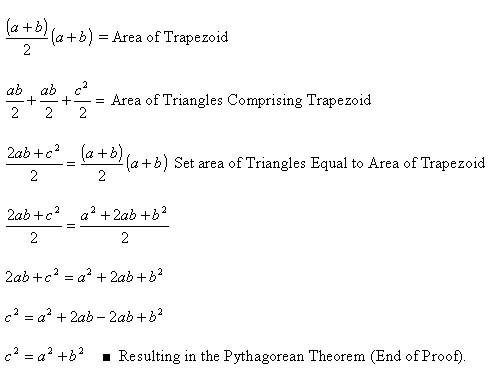
Whether the President was ever aware that the
Masonic symbol of the “Point Within a Circle” could be used to prove
Euclid's 47th Proposition in a manner so nearly identical
to that which he demonstrated is of course unknown. It does however
stir the imagination. President Garfield was, during his lifetime, a
teacher of mathematics with a deep and abiding interest in Geometry
(else there would likely be no Garfields’ Proof). As mentioned he
was also a Freemason and would have been acquainted with the “Point
Within a Circle”. I leave it to the reader to decide for himself
whether Garfields’ proof was inspired by Masonic symbolism. |


